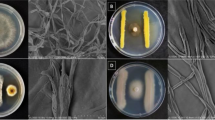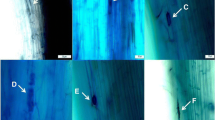Summary.
The scope of this work was to examine whether leaf constitutive secondary metabolites play a role in determining bacterial colonization of the phyllosphere. To this aim, we surveyed nineteen native or cultivated plant species that share a common bacterial pool in a North Mediterranean area, and estimated the size of total and ice nucleation active (INA) bacterial populations on their leaves. Large differences in the colonization of their phyllosphere were found; the population size of epiphytic bacteria ranged from 7.5 × 102 to 1 × 106 CFU/g fresh weight, in eucalypt and celery, respectively. Species native in Mediterranean-type climate areas, particularly those belonging to the group of aromatic plants, are characterized by scarce presence of INA bacteria. The antibacterial activity of essential oils, surface phenolics and leaf tissue extracts was also estimated against the INA strains P. syringae and E. herbicola, isolated from two of these plant species. E. herbicola proved more sensitive than P. syringae. Of the species examined, oregano [Origanum vulgare L. subsp. hirtum (Link.) Ietswaart], an aromatic plant, had the highest antimicrobial activity, whereas six species showed no activity at all. Further experiments were performed with oregano and bean (Phaseolus vulgaris L.) that represent two extremes in their secondary metabolite content. Both plants were inoculated with P. syringae. By the end of incubation, the bacterial population on bean plants was about 100 times higher than that on oregano leaves. Scanning electron micrographs showed that bacterial growth on oregano leaves was confined to sites away from glandular hairs. Results from the bacterial colonization survey together with those from the toxicity tests showed that all species rich in antibacterial secondary metabolites harbored low leaf bacterial populations. These results provide substantial evidence that leaf secondary metabolites function as constitutive defense chemicals against microbial invasions. However, the fact that species with non- or moderately active leaf secondary metabolites are not always highly colonized suggests mediation of other unknown factors, the contribution of which requires further investigation.
Similar content being viewed by others
Author information
Authors and Affiliations
Corresponding author
Rights and permissions
About this article
Cite this article
Karamanoli, K., Menkissoglu-Spiroudi, U., Bosabalidis, A.M. et al. Bacterial colonization of the phyllosphere of nineteen plant species and antimicrobial activity of their leaf secondary metabolites against leaf associated bacteria. Chemoecology 15, 59–67 (2005). https://doi.org/10.1007/s00049-005-0297-5
Received:
Accepted:
Issue Date:
DOI: https://doi.org/10.1007/s00049-005-0297-5




